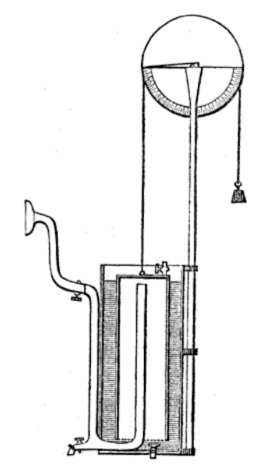
From “The Medical Examiner, and Record of Medical Science”, Volume 7, Issues 1-4, published by Lindsay & Blakiston, 1851, page 51.
“Another contribution from the domain of physics has been made, by Mr. Hutchinson, to the investigation of the respiratory functions in health and disease. It consists in an instrument he has invented, by which may be measured the amount of air that may be taken into and expelled from the lungs by voluntary effort; or what he calls “the vital capacity” of the lungs. By this instrument Mr. Hutchinson believes that incipient disease may be detected before physical signs exist. This instrument he names spirometer.
“On the table is an instrument of the kind. It is simple and less expensive than that of Mr. Hutchinson. It was planned by a gentleman of this city, Mr. Charles McKuen, who has been confined to his room for some months by a pulmonary affection; possessing an active mind, with a turn for philosophical pursuits, he occupies his time in scientific observations and investigations. I gave him Mr. Hutchinson’s paper, published in the Medico-Chirugical Transactions, containing a diagram of his instrument. Mr. McKuen constructed the instrument now before you on the same principles. I think it preferable to the original.
“The instrument will be seen to consist of a cylinder containing water, in which immersed is another cylinder inverted, into which the expired air finds its way. This cylinder is counterpoised by a weight attached to a cord passing over a wheel of large diameter, and which rotates with the ascent of the cylinder, caused by the entrance of expired air, and on which a scale indicates the amount that has be introduced.
“The person using this instrument must first loosen and part of his dress that may restrain the movements of the chest or abdomen. He then deliberately expands his chest to its greatest extent, and expires through the mouthpiece and air tube into the cylinder. As this rises the wheel turns round, and an index marks on the scale, in inches, the amount expired.”